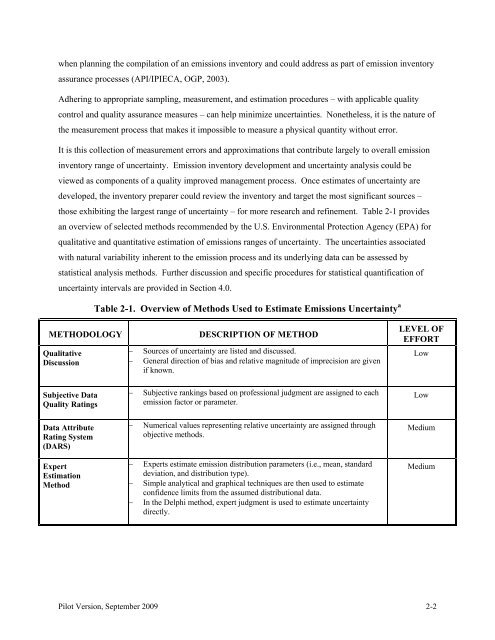addressing uncertainty in oil and natural gas industry greenhouse
addressing uncertainty in oil and natural gas industry greenhouse
addressing uncertainty in oil and natural gas industry greenhouse
You also want an ePaper? Increase the reach of your titles
YUMPU automatically turns print PDFs into web optimized ePapers that Google loves.
when plann<strong>in</strong>g the compilation of an emissions <strong>in</strong>ventory <strong>and</strong> could address as part of emission <strong>in</strong>ventory<br />
assurance processes (API/IPIECA, OGP, 2003).<br />
Adher<strong>in</strong>g to appropriate sampl<strong>in</strong>g, measurement, <strong>and</strong> estimation procedures – with applicable quality<br />
control <strong>and</strong> quality assurance measures – can help m<strong>in</strong>imize uncerta<strong>in</strong>ties. Nonetheless, it is the nature of<br />
the measurement process that makes it impossible to measure a physical quantity without error.<br />
It is this collection of measurement errors <strong>and</strong> approximations that contribute largely to overall emission<br />
<strong>in</strong>ventory range of <strong>uncerta<strong>in</strong>ty</strong>. Emission <strong>in</strong>ventory development <strong>and</strong> <strong>uncerta<strong>in</strong>ty</strong> analysis could be<br />
viewed as components of a quality improved management process. Once estimates of <strong>uncerta<strong>in</strong>ty</strong> are<br />
developed, the <strong>in</strong>ventory preparer could review the <strong>in</strong>ventory <strong>and</strong> target the most significant sources –<br />
those exhibit<strong>in</strong>g the largest range of <strong>uncerta<strong>in</strong>ty</strong> – for more research <strong>and</strong> ref<strong>in</strong>ement. Table 2-1 provides<br />
an overview of selected methods recommended by the U.S. Environmental Protection Agency (EPA) for<br />
qualitative <strong>and</strong> quantitative estimation of emissions ranges of <strong>uncerta<strong>in</strong>ty</strong>. The uncerta<strong>in</strong>ties associated<br />
with <strong>natural</strong> variability <strong>in</strong>herent to the emission process <strong>and</strong> its underly<strong>in</strong>g data can be assessed by<br />
statistical analysis methods. Further discussion <strong>and</strong> specific procedures for statistical quantification of<br />
<strong>uncerta<strong>in</strong>ty</strong> <strong>in</strong>tervals are provided <strong>in</strong> Section 4.0.<br />
Table 2-1. Overview of Methods Used to Estimate Emissions Uncerta<strong>in</strong>ty a<br />
METHODOLOGY<br />
Qualitative<br />
Discussion<br />
−<br />
−<br />
DESCRIPTION OF METHOD<br />
Sources of <strong>uncerta<strong>in</strong>ty</strong> are listed <strong>and</strong> discussed.<br />
General direction of bias <strong>and</strong> relative magnitude of imprecision are given<br />
if known.<br />
LEVEL OF<br />
EFFORT<br />
Low<br />
Subjective Data<br />
Quality Rat<strong>in</strong>gs<br />
−<br />
Subjective rank<strong>in</strong>gs based on professional judgment are assigned to each<br />
emission factor or parameter.<br />
Low<br />
Data Attribute<br />
Rat<strong>in</strong>g System<br />
(DARS)<br />
−<br />
Numerical values represent<strong>in</strong>g relative <strong>uncerta<strong>in</strong>ty</strong> are assigned through<br />
objective methods.<br />
Medium<br />
Expert<br />
Estimation<br />
Method<br />
−<br />
−<br />
−<br />
Experts estimate emission distribution parameters (i.e., mean, st<strong>and</strong>ard<br />
deviation, <strong>and</strong> distribution type).<br />
Simple analytical <strong>and</strong> graphical techniques are then used to estimate<br />
confidence limits from the assumed distributional data.<br />
In the Delphi method, expert judgment is used to estimate <strong>uncerta<strong>in</strong>ty</strong><br />
directly.<br />
Medium<br />
Pilot Version, September 2009 2-2

















